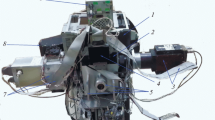Abstract—We report the development of a photosensor device based on a position-sensitive detector with a gallium arsenide (GaAs) cathode and a 16-element anode. In the case of asymmetric heterostatic circuit (electrodes combined in fours) its working field was limited by 10 mm (for a 18-mm photocathode). Implementing a scheme of analog coding of the coordinates of the centroids of electron avalanches arriving to the anode in the photosensor device made it possible to increase the field size to 14 mm and achieve a spatial resolution of 50 μm. The resulting photosensor device is used as the principal component of a multimode field photopolarimeter in observations with a microsecond time resolution on the 6-m telescope of the Special Astrophysical Observatory of the Russian Academy of Sciences. We report some of the results obtained in the process of this work.















Similar content being viewed by others
Notes
http://www.andor.oxinst/products/ixon-emccd-camera.
REFERENCES
M. R. Aibund, L. S. Gorn, M. A. Gruntman, et al., Pribory i tekhnika eksperimenta 1 (1), 70 (1984).
F. Ambrosino, A. Papitto, L. Stella, et al., Nature Astronomy 1, 854 (2017).
H. O. Anger, Review of Scientific Instruments 29 (1), 27 (1958).
G. Beskin, V. de-Bur, S. Karpov, et al., SPIE Conf. Ser., 7021, 702120 (2008).
G. M. Beskin, V. G. Debur, and V. L. Plokhotnichenko, Physics of Neutron Stars, St. Petersburg, May 25–26, 1999, 1 (1999).
V. de-Bur, A. Terekhov, S. Kosolobov, et al., AIP Conf. Ser. 984, 186 (2008).
V. Debur, T. Arkhipova, G. Beskin, et al., Nuclear Instruments and Methods in Physics Research A 513 (1–2), 127 (2003).
V. Debur and A. Solin, SAO RAS Technical Report No. 288, 1 (2002). [in Russian].
V. G. Debur, G. M. Beskin, S. V. Karpov, et al., Astrophysical Bulletin 64 (4), 386 (2009).
O. Dvornikov, Komponenty i tekhnologii 8, 184 (2005).
O. Dvornikov, V. Chekhovsky, and A. Solin, Chip news 11–12, 28 (1997). [in Russian].
S. S. Eikenberry, G. G. Fazio, and S. M. Ransom, Publ. Astron. Soc. Pacific 108, 939 (1996).
M. A. Gruntman, Pribory i tekhnika eksperimenta 1 (1), 14 (1984).
D. R. Harbeck, T. Boroson, M. Lesser, et al., SPIE Conf. Ser. 9147, 91470P (2014).
W. A. Hiltner, Astronomical techniques (1962).
M. A. C. Perryman, F. Favata, A. Peacock, et al., Astron. and Astrophys. 346, L30 (1999).
D. Phelan, O. Ryan, and A. Shearer, High Time Resolution Astrophysics, vol. 351 (2008).
V. Plokhotnichenko, G. Beskin, V. Debur, et al., Nuclear Instruments and Methods in Physics Research A 513 (1-2), 167 (2003).
V. Plokhotnichenko, G. Beskin, S. Karpov, et al., Advances in Astronomy 2010, 109681 (2010).
V. L. Plokhotnichenko, G. M. Beskin, S. V. Karpov, et al., Astrophysical Bulletin, 2020 (in press).
V. L. Plokhotnichenko, G. M. Beskin, V. G. de Bur, et al., Astrophysical Bulletin 64 (3), 308 (2009a).
V. L. Plokhotnichenko, G. M. Beskin, V. G. de Bur, et al., Astrophysical Bulletin 64 (3), 308 (2009b).
V. L. Plokhotnichenko, G. M. Beskin, V. G. de Bur, et al., Astrophysical Bulletin 64 (3), 308 (2009c).
V. L. Plokhotnichenko, G. M. Beskin, and V. G. Debur, Astrofizika na rubezhe vekov, Pushchino, May 17–22, 1999, 1 (1999).
V. L. Plokhotnichenko, V. G. de Bur, S. V. Moiseev, et al., SAO RAS Technical Report No. 337, 1 (2018). [in Russian]
R.W. Romani, A. J. Miller, B. Cabrera, et al., Astrophys. J. 563 (1), 221 (2001).
A. Shearer, J. Cunni_e, B. Voisin, et al., AIP Conf. Ser. 984, 225 (2008).
Y. A. Shibanov, G. M. Beskin, S. V. Karpov, et al., Journal of Physics Conf. Ser. 932, 012027 (2017).
ACKNOWLEDGMENTS
We are grateful to our colleagues who took part in the development of the detectors based on new principles.
Funding
This work was carried out within the framework of “Fundamental Research” government contract of the Special Astrophysical Observatory of the Russian Academy of Sciences and the Federal program “Kazan Federal University Competitive Growth Program.” This work was supported by the Russian Foundation for Basic Research (projects nos. 04-02-17555, 06-02-08313, and 09-02-12053), INTAS (project no. 04-78-7366), and CRDF (project no. RP1-2394-MO-02). This work was partially supported by European Structural and Investment Fund and the Czech Ministry of Education, Youth and Sports (Project CoGraDS—CZ.02.1.01/0.0/0.0/15 003/0000437).
Author information
Authors and Affiliations
Corresponding author
Ethics declarations
The authors declare no conflict of interest.
Additional information
Translated by A. Dambis
APPENDIX
APPENDIX
Shown are the diagram of the charge-sensitive amplifier and the scheme of obtaining the coadded signals for computing the coordinate X. A similar scheme is used for the Y coordinate (Fig. 16, Fig. 17).
Actual implementation of the scheme of analog coding of signals for the X coordinate on the board. HEADLER 3×2—sockets for connecting CSA, where (1) is the positive output; (3) the negative output; Xsump is the direct signal for operating amplifier Mx, and Xsumm is the inverted signal. Same for My (see Fig. 3).
Rights and permissions
About this article
Cite this article
Plokhotnichenko, V.L., Beskin, G.M., Karpov, S.V. et al. Photosensor Device Based on a 16-Electrode Position-Sensitive Detector with High Temporal Resolution. Astrophys. Bull. 75, 59–68 (2020). https://doi.org/10.1134/S199034132001006X
Received:
Revised:
Accepted:
Published:
Issue Date:
DOI: https://doi.org/10.1134/S199034132001006X






